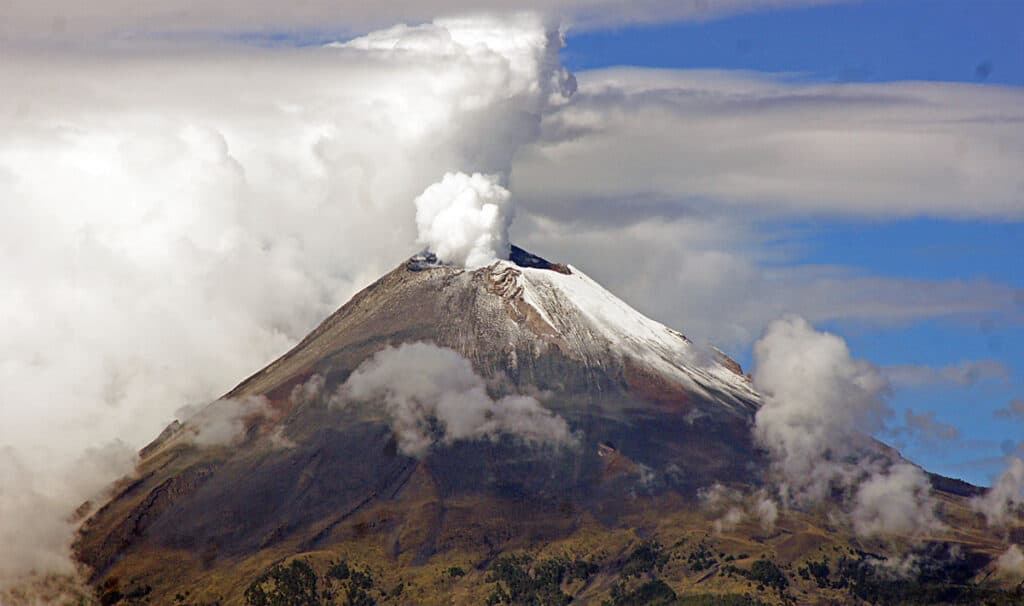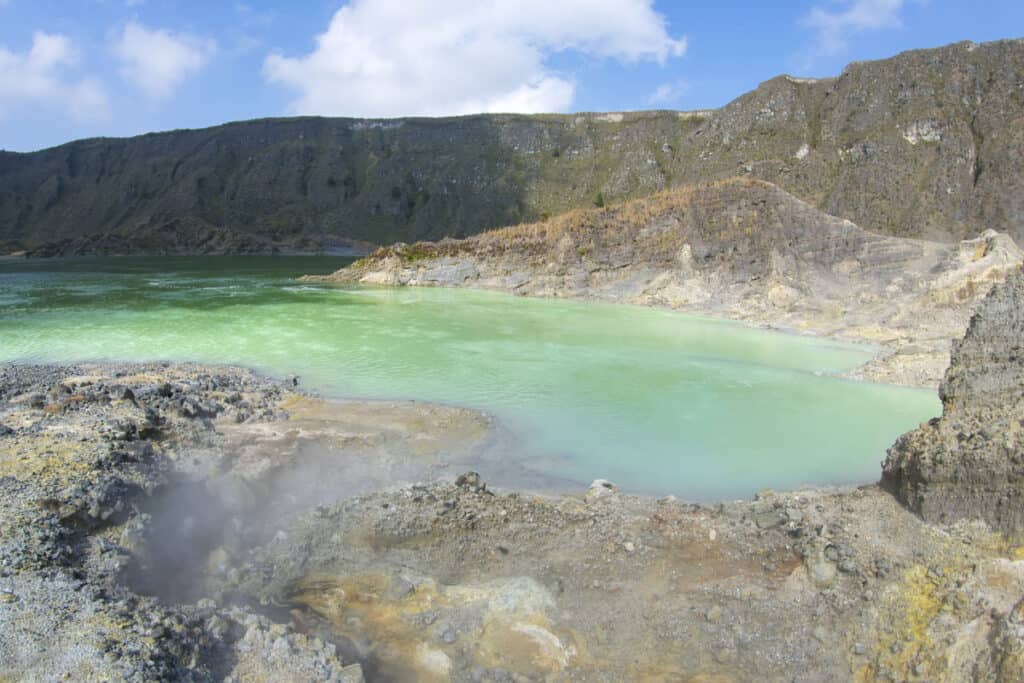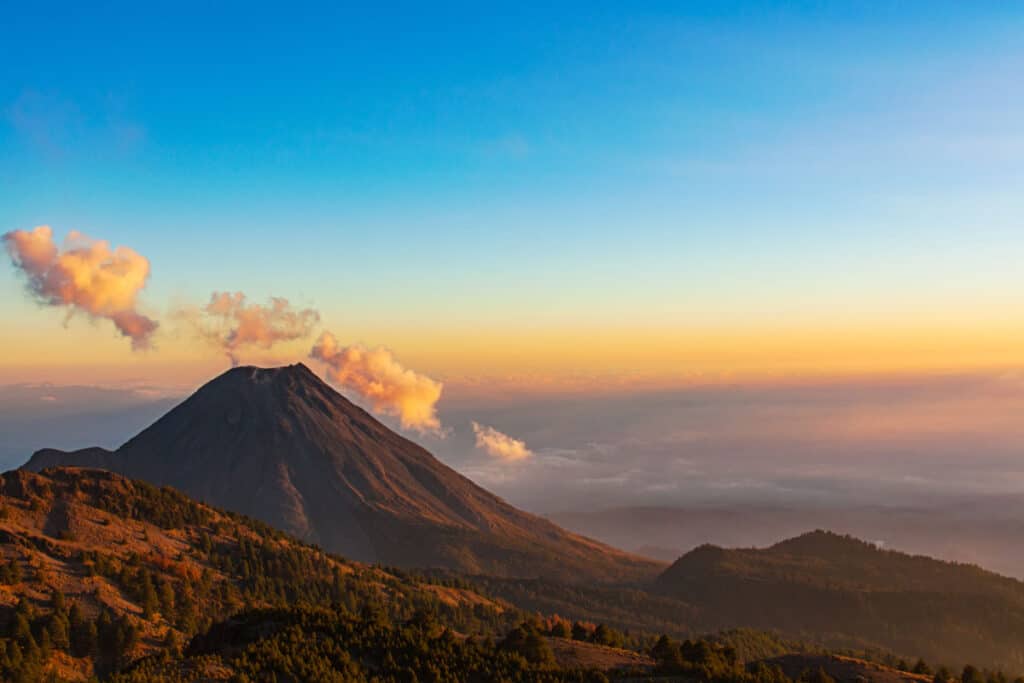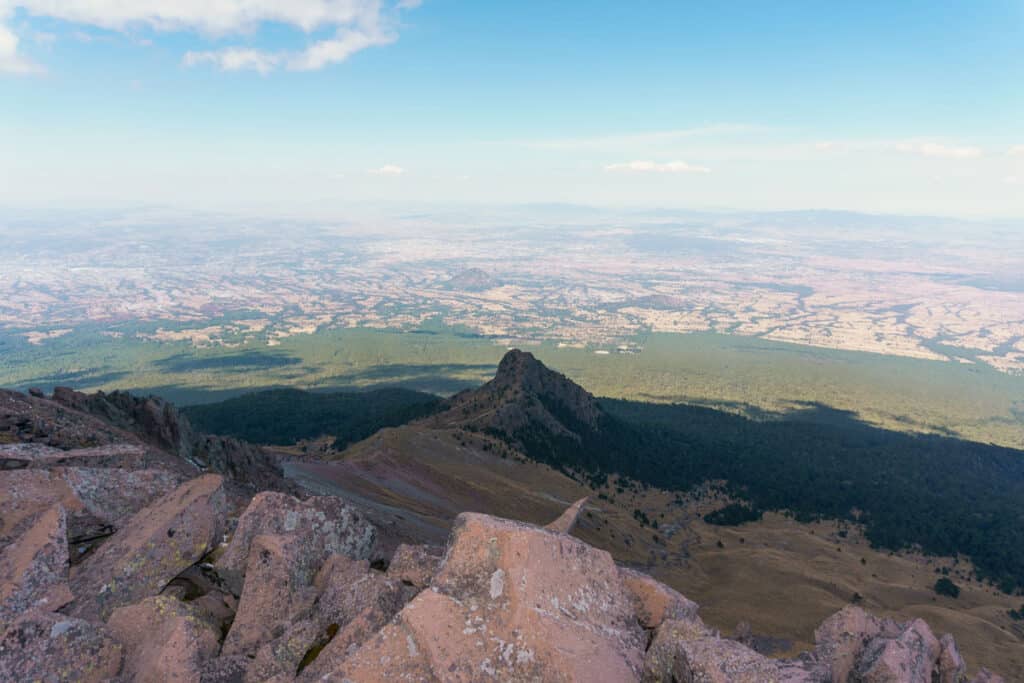Mexico City itself was built only 43 miles from an active volcano, so that should be enough to tell you that there are volcanoes abundant in this country. They are prevalent throughout Mexico’s history and culture.
The volcano in question near Mexico City is Popocatepetl, and it was the ancient Aztecs who initially decided to build a city there. However, still, we have to examine their reasoning. Mexico City is rapidly sinking because it was built in an ancient caldera crater.
Calderas form when eruptions force cones to collapse inward on themselves. They can be shallow or very deep and often form lakes, like the one where Mexico City put its roots.
Volcanoes have many moving parts, both figuratively and literally, and a rich history, especially in Mexico. Volcanoes begin as vents over magma chambers.
The heat and gasses push the magma up and out, becoming lava. When the lava cools, it becomes the base for a volcano, and more develops from there. There are five basic types of volcanoes, and let’s explore them.
Types of Volcanoes

There are five different types of volcanoes and three classes.
©iStock.com/Lyon Mathias
Volcanoes take hundreds of thousands of years to form into the products we know them as. They start as one type of volcano and eventually develop into others.
There are five categories of volcanoes and three ways to classify them. The five categories include:
- Cinder Cone Volcanoes- volcanoes that are formed from pyroclastic materials that collect loosely over time.
- Complex Volcanoes- volcanoes whose vents change placement over time due to shifting material.
- Composite/Strato- volcanoes formed from how material and lava flow over it, generally with a cone.
- Shield Volcanoes- when lava flows outward and forms the volcano in a shield shape.
- Spatter Cone Volcanoes- volcanoes that are formed by welded together fragments of pyroclastic material.
Volcanoes in Mexico are mostly cinder cone, strato-volcanoes, and shield volcanoes. Those three types are the most common.
There are three different ways to classify a volcano: active, dormant, and extinct.
- Active: is a volcano that has had seismic activity in recent years and will continue to have activity.
- Dormant: is a volcano that may or may not have had seismic activity in the last 10,000 years and could again.
- Extinct: is a volcano that will not ever be active again and likely does not have access to a magma chamber anymore and has not been active in more than 10,000 years.
All types of volcanoes can be found along the transmexican volcanic belt.
What is the Transmexican Volcanic Belt?

The Transmexican Volcanic Belt is a string of volcanoes crossing through central Mexico.
©Leonid Andronov/Shutterstock.com
The transmexican volcanic belt is a belt of volcanos that extends through the middle territory of Mexico and its southern states. Many of these volcanoes are, in fact, active, which is something we will explore later in this article.
This belt of volcanic activity crosses nearly 100,000 miles and is unique because it does not run parallel to the Middle American Trench like other volcanic belts. The volcanoes that make it up are also of different varieties and spewing different types of lava.
It is unusual for volcanic belts to have different composite material released from volcanoes in similar areas. That is because volcanoes close together might come from the same magma chamber. So this means there are pockets of different types of material moving beneath the earth.
How Many Volcanoes Does Mexico Have?

Mexico has volcanoes in total.
©iStock.com/Jonathan Ross
Mexico is home to numerous volcanoes, laying its claim along with its central and southern territories. Volcanoes and Mexico have a rich interwoven history because of how many there are compared to the country’s size.
Areas around volcanoes are known to have richer soil, so it makes sense that ancient people would place their homes around ones that have not been active in many years.
The volcano closest to Mexico City, Popocatepetl, is more than 700,000 years old and is a popular tourist and local attraction due to its vicinity to the capital. We will talk more about this volcano later in the article.
How Many Active Volcanoes Does Mexico Have?

Mexico has 48
active volcanoes
currently.
©Frederick Millett/Shutterstock.com
There are currently 48 active volcanoes in Mexico. An active volcano has had volcanic activity in the last 10,000 years and definitely can again. It doesn’t mean that the volcano will erupt soon, just that the possibility is there.
Volcanoes don’t affect Mexican citizens’ health too severely because there aren’t consistent eruptions spreading ash or pyroclastic material. The last volcano to erupt was in 1982 in Chiapas when the volcano called Chichon erupted after 850 years.
This is proof that volcanoes can erupt even after almost a thousand years of inactivity. Mexico’s volcanoes are also a part of the Pacific Rim of Fire, extending across the Pacific Ocean and partly underwater.
Much volcanic activity takes place underwater and with seamount volcanoes, so it doesn’t affect aboveground.
In recent years, Mexico has had a large eruption, with Popocatepetl having erupted in June of 2019, shooting out lava and ash. In July of 2019, it erupted three times and sent out lots of ash to coat the sky and surrounding areas.
Ash can pose a health risk if inhaled, so residents are usually asked to remain inside and limit activities when eruptions occur. Imagine living in the modern-day near a volcano erupting. It must have been amazing.
Popocatepetl

Popocatepetl means “fierce warrior” and is present in Aztec mythology.
©iStock.com/Eduardo Cabanas
Mentioned multiple times already, Popocatepetl has a rich history within Mexico. In the Aztec mythology, Popocatepetl is a “fierce warrior” who had a tragic love story. He and his partner were turned into snowy mountains, which are reminiscent of the tops of Mexico’s volcanoes.
After 70 years of inactivity, Popocatepetl started emitting steam in 1993. Over the years, its increased activity has warned scientists and residents that an eruption could be imminent. As stated earlier, it erupted in 2019 multiple times. So it was more than a twenty-year buildup.
People typically enjoy hiking and visiting Popocatepetl, but due to its erratic nature and tendency to sometimes be active, that is less common these days.
Iztaccihuatl

The last time Iztaccihuatl had activity was a gas eruption in October 2019, but it hasn’t had any seismic activity lately which is why it is classified as dormant.
©iStock.com/NAILOTL
This volcano is the legendary partner to Popocatepetl, the “white woman” who was turned into a snowy mountain in the Aztec myth. The four tops of its peaks together look like a sleeping woman coated in snow.
Unlike its partner, Iztaccihuatl is a dormant volcano instead of an active one. Many people choose to hike and visit it. The tops are covered in glaciers, ice, and snow. There is a mountain pass between Iztaccihuatl and Popocatepetl.
The last time Iztaccihuatl had activity was a gas eruption in October 2019, but it hasn’t had any seismic activity lately which is why it is classified as dormant.
El Chichon

Hot springs spot along the surface of El Chichon, and it has a crater filled with an acid green lake.
©iStock.com/shakzu
El Chichon’s volcano has a diameter of 6 miles at the base and is a very famous volcano in Mexico. There was a massive eruption in 1982 that decimated the lava dome it had along its peak.
A lava dome forms when the lava is too thick to flow downward, so it pools together. El Chichon was unknown until this eruption in 1982. Hot springs spot along the surface of El Chichon, and it has a crater filled with an acid green lake.
This is an example of the massive changes that can occur because of volcanoes. They really can change the landscape of our earth on a whim.
Colima

Colima is one of the most active volcanoes and most dangerous on the North American continent.
©iStock.com/DJColby
Volcan de Colima, also known just as Colima, is a very active volcano located in Mexico. It is a strato-volcano that has been active over the last twenty-five years. In fact, it is one of the most active volcanoes and most dangerous on the North American continent.
This strato-volcano tends to erupt in a very explosive manner, and it is covered in lava domes. Eruptions and other destructive activities have been happening at Colima since 1994 and haven’t slowed down.
Colima is known as the “fire volcano” because of its violent eruptions. The last one took place in 2015, and it still has the constant activity of lava and smoke. Tourists can gaze upon Colima, but there is no exploring its incendiary surface.
La Malinche

La Malinche is relatively easy to reach. It is considered dormant and on its way to extinction, but we will not rule out that it could potentially erupt in the future.
©iStock.com/NAILOTL
Another famous volcano, La Malinche, is a common tourist attraction because it has beautiful forests and hiking trails. It is not difficult to traverse and has plenty to do.
It is a strato-volcano only 25 miles from Puebla, so relatively easy to reach. It is considered dormant and on its way to extinction, but we will not rule out that it could potentially erupt in the future. That’s why scientists are monitoring it.
The string of volcanoes that litters Mexico is full of constant activity. It is a testament to the strength of the people living there, amongst the volcanoes, that they utilize them for something as simple as a tourist attraction.
These great giants can change the course of history, which is why scientists are always watching, observing, and waiting.
Up Next
- 10 Magnificent Mountains in Mexico
- The Legendary Black Demon Shark of Mexico
- How Many Volcanoes are in the World?
The photo featured at the top of this post is © iStock.com/Eduardo Cabanas
FAQs (Frequently Asked Questions)
How many volcanoes are currently active in Mexico?
There are 5 volcanoes currently active in Mexico.
- La Malinche
- Colima
- El Chichon
- Iztaccihuatl
- Popocatepetl
What is the Transmexican Volcanic Belt?
The transmexican volcanic belt is a belt of volcanos that extends through the middle territory of Mexico and its southern states. Many of these volcanoes are, in fact, active.
Thank you for reading! Have some feedback for us? Contact the AZ Animals editorial team.






